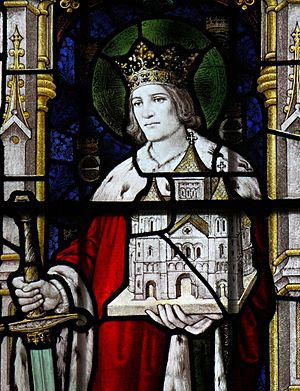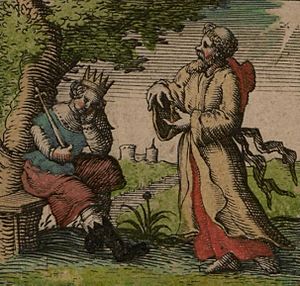Edwin of Northumbria facts for kids
Quick facts for kids Edwin of Northumbria |
|
|---|---|

St. Edwin of Northumbria depiction at St Mary, Sledmere, Yorkshire
|
|
| King of Deira and Bernicia | |
| Reign | 616 – 12 October 632/633 |
| Predecessor | Æthelfrith |
| Born | c. 586 Deira, England |
| Died | 12 October 633 (aged 46–47) Hatfield Chase, England |
| Spouse | Cwenburg Æthelburg of Kent |
| Issue | Osfrith, Uscfrea, Eadfrith, Æthelhun, Eanflæd, Æthelthryth |
| Father | Ælle |
Edwin (also known as Eadwine) was a powerful king in early England. He ruled the kingdoms of Deira and Bernicia from about 616 until his death. These two kingdoms later joined to become Northumbria. Edwin became famous for converting to Christianity and being baptised in 627. After he died in a battle, he was honored as a saint.
Edwin was the son of Ælle, the first known king of Deira. He had at least two siblings. His sister Acha married Æthelfrith, who was king of the nearby kingdom of Bernicia.
Contents
King Edwin: A Powerful Anglo-Saxon Ruler
Edwin's Early Life and Exile
When Edwin's father, King Ælle, died, another ruler named Æthelfrith took control. Æthelfrith became king of both Deira and Bernicia by 604. This meant Edwin had to leave his home and live in exile. We don't know exactly where he went as a child. Some old stories say he stayed with King Cadfan ap Iago in Gwynedd, a kingdom in Wales.
By the 610s, Edwin was living in Mercia, protected by King Cearl. Edwin even married Cearl's daughter, Cwenburg. Later, around 616, Edwin found safety in East Anglia with King Rædwald. King Æthelfrith tried to convince Rædwald to kill Edwin, but Rædwald's wife stopped him.
Instead, Rædwald fought Æthelfrith in a battle by the River Idle in 616. Rædwald won, and Æthelfrith was defeated. After this victory, Rædwald helped Edwin become the new king of Northumbria. Æthelfrith's sons had to flee to other lands. Edwin's ability to rule both Deira and Bernicia showed how much support he had from Rædwald.
Becoming a Powerful King
After Æthelfrith died, Edwin became a very strong ruler in England. He expanded his kingdom by taking over other areas. For example, he drove out the ruler of the small British kingdom of Elmet around 616 or 626. He also took control of the larger kingdom of Lindsey around 625.
Edwin made an important alliance with Eadbald of Kent, the king of Kent. Edwin planned to marry Eadbald's sister, Æthelburg. However, King Eadbald would only agree if Edwin promised to become a Christian. This marriage was very important because it led to Christianity spreading in Northumbria, just as Eadbald's mother had helped convert Kent.
Edwin also expanded his power to the west. He fought a war in the early 620s against King Fiachnae mac Báetáin of the Ulaid in Ireland. There are records of a siege on Bamburgh in Bernicia around 623–624. This was likely part of Edwin's plan to control the Isle of Man, which was also important to the Ulaid. By the time Edwin died, his kingdom likely stretched from the Humber and Mersey rivers north to the Southern Uplands.
Kings in Edwin's time often fought wars each year. These wars helped them gain tribute, submission from other rulers, and slaves. Edwin's royal family traveled often, moving from one royal estate to another. This helped them collect taxes, give out justice, and show their power across the land. Important royal sites included Yeavering in Bernicia and York, a former Roman city.
Edwin's Conversion to Christianity
The story of Edwin becoming a Christian is well-known. It involves two main events. First, during his exile, a man named Paulinus of York saved Edwin's life. Second, after his marriage to Æthelburg, someone tried to kill Edwin in York in 626. After this attack, Edwin promised to become a Christian if he won against his enemies.
Edwin's wife, Queen Æthelburg, was also very influential. She was Christian, and letters from Pope Boniface V to Edwin and Æthelburg encouraged his conversion. On April 12, 627, Edwin and his main advisors were baptised. Edwin's strong belief even led to King Eorpwald, Rædwald's son, also converting.
Bede, a famous historian, tells the story of Edwin's conversion. After Paulinus explained Christianity, Edwin asked his advisors what they thought. Coifi, Edwin's pagan priest, said that the old gods hadn't brought him any benefits. He suggested the new faith might be better. Another advisor compared human life to a sparrow flying through a warm hall in winter. He said that life is short and unknown, like the sparrow's flight. If the new teaching offered more certainty, it should be followed.
Coifi then spoke again, saying they should destroy the old idols. Edwin agreed. Coifi himself rode Edwin's horse to the temple, armed with a sword and spear. He threw a spear into the temple, showing he was giving up his old beliefs.
Bede also wrote about the peace during Edwin's reign. He said that "a woman with a recently born child" could walk "across the whole island, from sea to sea, without anyone harming her." This shows how safe and peaceful Edwin's kingdom was.
However, after Edwin's death, many people in Northumbria went back to paganism. Paulinus, the Christian leader, left Northumbria. This suggests that Christianity had not yet spread deeply beyond the royal court.
Edwin as Overlord of England
Around 627, Edwin became the most powerful king among the Anglo-Saxons. He ruled Bernicia, Deira, parts of Mercia, the Isle of Man, and Anglesey. His alliance with Kent and his victories made him very strong. Bede called his power imperium, which means he had great authority over other kings.
Edwin faced a challenge from his supposed foster-brother, Cadwallon ap Cadfan, around 629. But Cadwallon was defeated and either submitted to Edwin or went into exile. For several years, Edwin's power was unchallenged. However, in 632–633, Penda of Mercia and Cadwallon joined forces against him.
His Death and Lasting Legacy
Edwin fought Penda and Cadwallon at the Battle of Hatfield Chase in the autumn of 632 or 633. Edwin was defeated and killed in this battle. His head was later buried in York, and the rest of his body was buried at Whitby. Edwin had two grown sons by Cwenburh. Osfrith died at Hatfield, and Eadfrith was captured by Penda and killed later.
After Edwin's death, his queen, Æthelburg, and Paulinus returned to Kent. They took Edwin's son Uscfrea and daughter Eanflæd with them. Eanflæd later married her cousin, King Oswiu.
Edwin's kingdom was divided after his death. His successors, Osric in Deira and Eanfrith in Bernicia, both returned to paganism. Both were killed by Cadwallon. Eventually, Eanfrith's brother Oswald defeated Cadwallon and reunited Northumbria.
After his death, some people honored Edwin as a saint. However, the worship of Oswald, who died later, became more popular. Both Edwin and Oswald died fighting pagan enemies, so they were seen as martyrs. But Bede, the historian, clearly thought Oswald was more saintly than Edwin.
| Edwin of Northumbria | |
|---|---|
| Convert, King, Martyr | |
| Venerated in | Eastern Orthodox Church, Roman Catholic Church, Anglican Communion |
| Feast | 12 October |
| Patronage | converts; hoboes; homeless people; kings; parents of large families |
Edwin's fame mostly comes from Bede's writings, which were from a Christian and English point of view. His main legacy is his conversion to Christianity. His united kingdom did not last long after him, and his successors rejected Christianity. Compared to other powerful kings of his time, Edwin might seem less important. However, his reign led to the rise of Mercia and the return of Æthelfrith's sons, which connected Northumbria to the Irish Sea region for many years.
See also
 In Spanish: Edwino de Deira para niños
In Spanish: Edwino de Deira para niños
- List of Catholic saints
- Christianisation of Anglo-Saxon England


